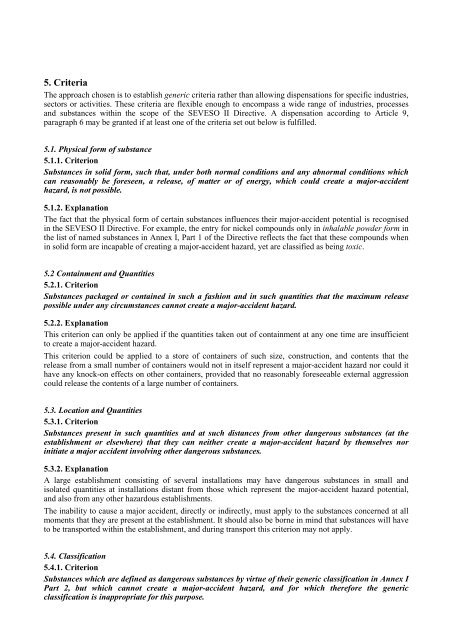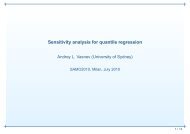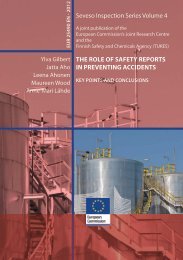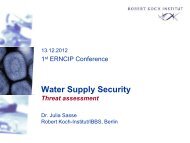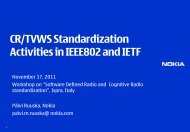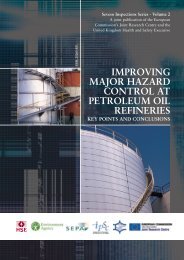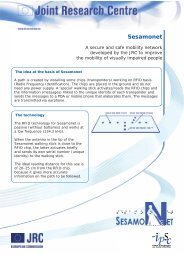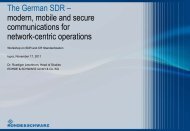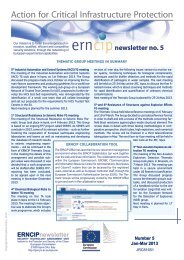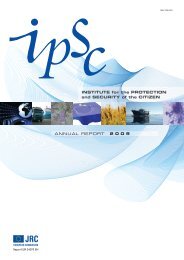Directive 96/82/EC "SEVESO II" - IPSC - Europa
Directive 96/82/EC "SEVESO II" - IPSC - Europa
Directive 96/82/EC "SEVESO II" - IPSC - Europa
Create successful ePaper yourself
Turn your PDF publications into a flip-book with our unique Google optimized e-Paper software.
5. Criteria<br />
The approach chosen is to establish generic criteria rather than allowing dispensations for specific industries,<br />
sectors or activities. These criteria are flexible enough to encompass a wide range of industries, processes<br />
and substances within the scope of the <strong>SEVESO</strong> II <strong>Directive</strong>. A dispensation according to Article 9,<br />
paragraph 6 may be granted if at least one of the criteria set out below is fulfilled.<br />
5.1. Physical form of substance<br />
5.1.1. Criterion<br />
Substances in solid form, such that, under both normal conditions and any abnormal conditions which<br />
can reasonably be foreseen, a release, of matter or of energy, which could create a major-accident<br />
hazard, is not possible.<br />
5.1.2. Explanation<br />
The fact that the physical form of certain substances influences their major-accident potential is recognised<br />
in the <strong>SEVESO</strong> II <strong>Directive</strong>. For example, the entry for nickel compounds only in inhalable powder form in<br />
the list of named substances in Annex I, Part 1 of the <strong>Directive</strong> reflects the fact that these compounds when<br />
in solid form are incapable of creating a major-accident hazard, yet are classified as being toxic.<br />
5.2 Containment and Quantities<br />
5.2.1. Criterion<br />
Substances packaged or contained in such a fashion and in such quantities that the maximum release<br />
possible under any circumstances cannot create a major-accident hazard.<br />
5.2.2. Explanation<br />
This criterion can only be applied if the quantities taken out of containment at any one time are insufficient<br />
to create a major-accident hazard.<br />
This criterion could be applied to a store of containers of such size, construction, and contents that the<br />
release from a small number of containers would not in itself represent a major-accident hazard nor could it<br />
have any knock-on effects on other containers, provided that no reasonably foreseeable external aggression<br />
could release the contents of a large number of containers.<br />
5.3. Location and Quantities<br />
5.3.1. Criterion<br />
Substances present in such quantities and at such distances from other dangerous substances (at the<br />
establishment or elsewhere) that they can neither create a major-accident hazard by themselves nor<br />
initiate a major accident involving other dangerous substances.<br />
5.3.2. Explanation<br />
A large establishment consisting of several installations may have dangerous substances in small and<br />
isolated quantities at installations distant from those which represent the major-accident hazard potential,<br />
and also from any other hazardous establishments.<br />
The inability to cause a major accident, directly or indirectly, must apply to the substances concerned at all<br />
moments that they are present at the establishment. It should also be borne in mind that substances will have<br />
to be transported within the establishment, and during transport this criterion may not apply.<br />
5.4. Classification<br />
5.4.1. Criterion<br />
Substances which are defined as dangerous substances by virtue of their generic classification in Annex I<br />
Part 2, but which cannot create a major-accident hazard, and for which therefore the generic<br />
classification is inappropriate for this purpose.


